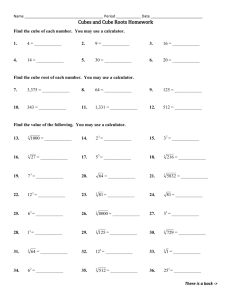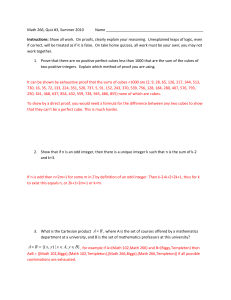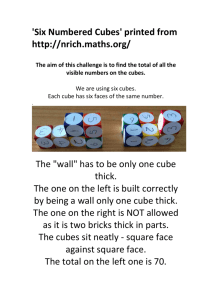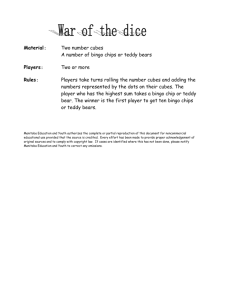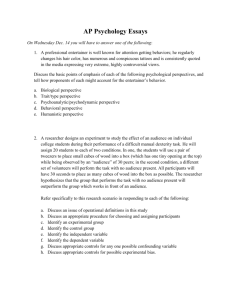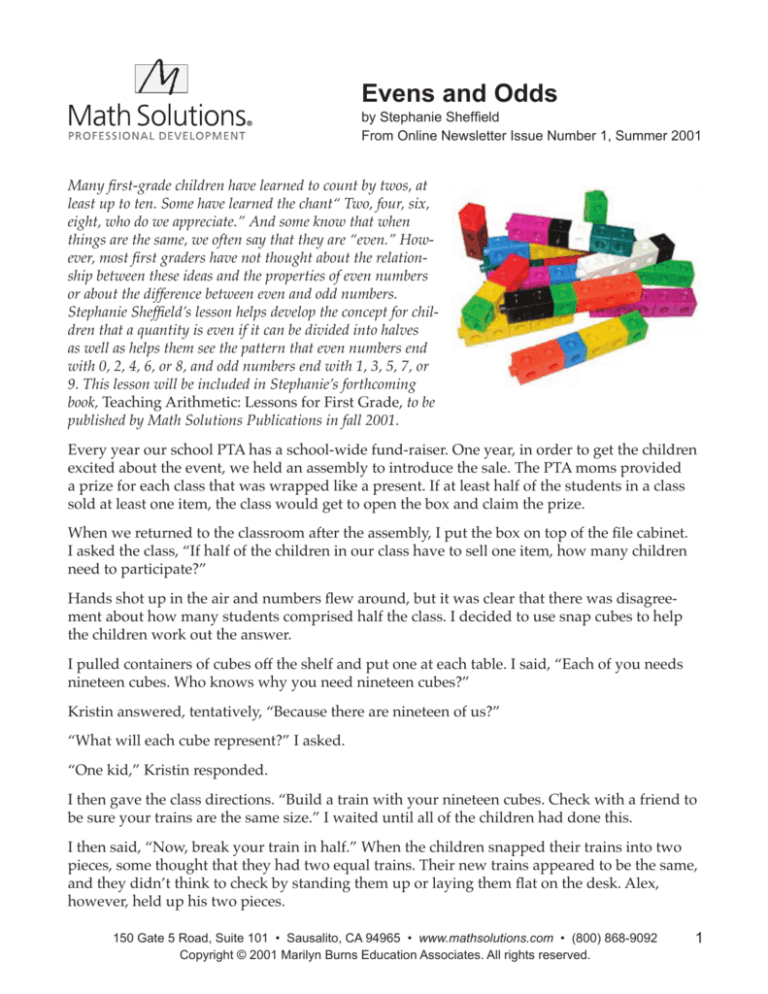
Evens and Odds
by Stephanie Sheffield
From Online Newsletter Issue Number 1, Summer 2001
Many first-grade children have learned to count by twos, at
least up to ten. Some have learned the chant“ Two, four, six,
eight, who do we appreciate.” And some know that when
things are the same, we often say that they are “even.” However, most first graders have not thought about the relationship between these ideas and the properties of even numbers
or about the difference between even and odd numbers.
Stephanie Sheffield’s lesson helps develop the concept for children that a quantity is even if it can be divided into halves
as well as helps them see the pattern that even numbers end
with 0, 2, 4, 6, or 8, and odd numbers end with 1, 3, 5, 7, or
9. This lesson will be included in Stephanie’s forthcoming
book, Teaching Arithmetic: Lessons for First Grade, to be
published by Math Solutions Publications in fall 2001.
Every year our school PTA has a school-wide fund-raiser. One year, in order to get the children
excited about the event, we held an assembly to introduce the sale. The PTA moms provided
a prize for each class that was wrapped like a present. If at least half of the students in a class
sold at least one item, the class would get to open the box and claim the prize.
When we returned to the classroom after the assembly, I put the box on top of the file cabinet.
I asked the class, “If half of the children in our class have to sell one item, how many children
need to participate?”
Hands shot up in the air and numbers flew around, but it was clear that there was disagreement about how many students comprised half the class. I decided to use snap cubes to help
the children work out the answer.
I pulled containers of cubes off the shelf and put one at each table. I said, “Each of you needs
nineteen cubes. Who knows why you need nineteen cubes?”
Kristin answered, tentatively, “Because there are nineteen of us?”
“What will each cube represent?” I asked.
“One kid,” Kristin responded.
I then gave the class directions. “Build a train with your nineteen cubes. Check with a friend to
be sure your trains are the same size.” I waited until all of the children had done this.
I then said, “Now, break your train in half.” When the children snapped their trains into two
pieces, some thought that they had two equal trains. Their new trains appeared to be the same,
and they didn’t think to check by standing them up or laying them flat on the desk. Alex,
however, held up his two pieces.
150 Gate 5 Road, Suite 101 • Sausalito, CA 94965 • www.mathsolutions.com • (800) 868-9092
Copyright © 2001 Marilyn Burns Education Associates. All rights reserved.
1
Evens and Odds, continued
“I don’t think this is right. They don’t match,” he said.
“Yeah, they’re supposed to be the same,” Andrea agreed, comparing her two trains.
“What do you mean by that?” I asked.
“It’s like an apple,” Richard explained. “If you cut it in half, you and your friend each get a
part. But it has to be fair.”
“So if you cut something in half, how many parts do you get?” I asked.
“Two!” they all said together.
“And what can you tell me about the two parts?” I continued.
“They are always the same,” Mukund replied.
“Equal,” Christian added.
“The question is, how many students are there in half our class?” I said. “How can the cubes
help you find out?”
Kevin answered, “It’s either eight or nine. One of the trains has eight and one has nine.” Kevin
had miscounted the cubes, but he was aware that the trains were one cube apart.
I said, “But if we break our train into halves, each has to be the same length. How can you
divide a train with nineteen cubes into halves?” Students tried over and over, snapping the
cubes together and then separating them. Each time the result was unequal trains.
Finally, Chloe said, “I just don’t think this is going to work. One train is always one cube
taller.”
“It would work if we threw out one cube,” Christian suggested.
“It won’t work!” Kierra cried in exasperation. “One of the trains is always bigger than the
other one.”
Since some of the students were becoming frustrated, I stopped their investigation for a few
minutes of discussion. I said, “The reason this is difficult is that we can’t cut a cube in half and
put part of it on one train and part on the other train. But using cubes is still a good model for
solving our problem about how many children make half the class because we can’t divide a
student up, either. For this problem, the best we can do is to say that half of our class is either
nine or ten.”
“Let’s use nine!” Andrea exclaimed. “That way we’ll have a better chance of getting to open
the box!”
I then extended the question to have students use cubes to investigate dividing other whole
numbers in half. I said, “Kierra said that nineteen doesn’t work. Who knows what she means
by that?”
Lauren said, “She means you can’t split it into two even trains.”
150 Gate 5 Road, Suite 101 • Sausalito, CA 94965 • www.mathsolutions.com • (800) 868-9092
Copyright © 2001 Marilyn Burns Education Associates. All rights reserved.
2
Evens and Odds, continued
“Do you know a number of cubes that a train could have so it does work to split it into
halves?” I asked.
Chloe raised her hand. “If we got rid of a cube, we’d have eighteen, and that works,” she said.
The children verified with the cubes that this was so. I went to the board and drew a vertical line to make two columns. I titled the left-hand column “Works” and the other column
“Doesn’t Work.” I recorded 19 under “Doesn’t Work” and 18 under “Works.”
I got the children’s attention and gave directions for further exploration. “You’ll each choose a
number between ten and twenty.” Immediately, hands dove into the containers of cubes. I took
a minute to call them back to attention and I waited until all hands were off the cubes.
Then I continued, “After you count out the cubes, make a train and try to break it in half. Be
ready to report to the class the number you chose and if it belongs in the ‘Works’ or ‘Doesn’t
Work’ column.”
The children went to work. Some unsnapped the cubes in their trains and then began over
again to count out cubes. Some started with the train of nineteen and took some cubes away.
When I saw that all of the children had explored at least one number, I called for their attention. I called on several children to report on the numbers they had investigated, recording
each number on the board in the correct column to indicate whether it could or couldn’t be
broken into two equal parts.
150 Gate 5 Road, Suite 101 • Sausalito, CA 94965 • www.mathsolutions.com • (800) 868-9092
Copyright © 2001 Marilyn Burns Education Associates. All rights reserved.
3
Evens and Odds, continued
After I had recorded six numbers, I focused the class
on the labels of the columns. I asked, “Who can explain
what we mean by ‘Works’ and ‘Doesn’t Work’”?
I waited until most of the children raised their hands and
then called on Mukund. “All the numbers that work, you
can make two trains that are the same with them,” he
said.
Next I called on Tatyana. “Those numbers,” she said, indicating the “Doesn’t Work” column, “all have a leftover
cube when you try to break it into half, but the other ones
work without a leftover.”
I continued asking children to report numbers until I had
recorded all of the numbers from 10 to 20. Sometimes
children reported a number that I had already recorded.
In these cases, we used the information as a check.
I then asked the class to consider numbers less than ten,
this time first making a prediction about whether or not
the number would work, and then building the train and
snapping it in two. To begin, I asked the class, “Do you
think six will work or not?”
Richard responded, “I think it will because I know that
three and three is six.” Some children agreed and others
weren’t sure.
I said, “When you make a prediction as Richard did, you
can then test your prediction with the cubes. You’d build
a train with six cubes and see if you can break it into
halves.”
I stopped the children from doing this immediately and
gave the class one more direction. I said, “See what you
can find out about numbers smaller than ten. Each time, make a prediction first, and then test
your idea with the cubes.” The children got busy again.
“All the doubles work!” Andrea exclaimed after a few minutes. “Three and three is six, and
four and four is eight, and five and five is ten!”
Lauren stopped her building and looked at the chart. Then she looked at Andrea and said, “All
the numbers on the ‘Works’ side are doubles. See, there’s eight and eight is sixteen, and six and
six is twelve.”
After a few more minutes, I called the class back to attention again. I had students report the
numbers they had investigated and I recorded them in the correct columns. I did a quick check
to be sure that I had recorded all of the numbers.
150 Gate 5 Road, Suite 101 • Sausalito, CA 94965 • www.mathsolutions.com • (800) 868-9092
Copyright © 2001 Marilyn Burns Education Associates. All rights reserved.
4
Evens and Odds, continued
I then said, “There’s another label we could give to each
of these columns.” On the board I wrote Even Numbers
above “Works” and Odd Numbers above “Doesn’t Work.”
“Do we have an even number of students in our class or
an odd number?” I asked.
“An odd number!” was the resounding response.
“Can someone explain what you think even numbers
are?” I asked.
Jesse volunteered: “All the even numbers, you can make
a train with them and then make two even trains, but the
odd ones don’t work.” Heads nodded and children murmured their assent.
I now posed a related question. “What if we had nineteen
cookies? Could we split them into two equal parts? Talk
to your neighbor about what you think.”
After a few minutes I asked for discussion. Kierra raised her hand. “Cookies are different,” she
said. “You can cut cookies in half, but you can’t cut cubes.”
Reordering and Recording
I asked each student to take out a piece of paper and a pencil, draw a line, and label the lefthand column Even Numbers and the right-hand column Odd Numbers. I did this on the board
and waited until they had all done so on their papers. One reason I wanted them to have the
experience of recording the numbers themselves is that sometimes when they do the writing
themselves, they notice patterns they missed when looking at the board. Also, this serves as a
model for organizing lists of numbers and gives them a model for forming the numerals correctly. And lastly, if they have this record to take home, it may spark a conversation with their
parents about the math they did in school today. Having the papers in their hands provides a
starting point for this discussion and helps them remember the mathematics involved.
“You’ll each write down the numbers from each column, but we’ll put the numbers in order
from least to greatest. Let’s do it together. What’s the smallest number you see on the board in
the ‘Even Numbers’ column?” They all responded, “Two,” and I wrote it at the top of the new
column I had labeled. The next larger number they found was four, then six, then eight. By
now, many of the children noticed the pattern of counting by twos and they reported quickly,
without searching. But since many of them were less confident counting by twos beyond ten or
twelve, they slowed down a bit at that point. We ordered the numbers in the “Odd” column in
the same way.
When we had ordered all of the numbers, I asked, “What patterns do you notice when you
write the numbers this way?”
Richard raised his hand. “The even numbers go two, four, six, eight, then the numbers on the
right side go zero, two, four, six, eight.”
150 Gate 5 Road, Suite 101 • Sausalito, CA 94965 • www.mathsolutions.com • (800) 868-9092
Copyright © 2001 Marilyn Burns Education Associates. All rights reserved.
5
Evens and Odds, continued
“And the odd numbers go one, three, five, seven, nine,” Angelo said.
The underlying mathematics of even and odd numbers and their relation to doubles and
halves is important to a first grader’s growing number sense. While this investigation arose
from a situation that occurred naturally in our classroom, the opportunity doesn’t always come
up. Still, I can provide the children the same opportunity by structuring the lesson around a
different situation that calls for figuring out how many children are in half the class. For example, if we divide the class into two teams, can we have the same number of children on each
team? Or, if half of our class gets photos taken before lunch and half after lunch, how many
will be in each group? Whatever the problem, I always use the cubes so that children have the
chance to verify their thinking with physical objects.
150 Gate 5 Road, Suite 101 • Sausalito, CA 94965 • www.mathsolutions.com • (800) 868-9092
Copyright © 2001 Marilyn Burns Education Associates. All rights reserved.
6


